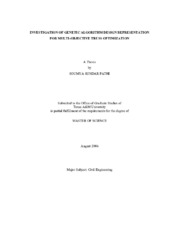| dc.description.abstract | The objective of this research is to develop a flexible design grammar and
genetic algorithm representation to be used in a multi-objective optimization method to
design efficient steel roof trusses given space dimensions and loading requirements by
the user. The goal of implementing the method as a multi-objective problem is to obtain
a set of near-optimal trusses for the defined unstructured problem domain, not just a
single near-optimal design. The method developed was required to support the
exploration of a broad range of conceptual designs before making design decisions.
Therefore, a method was developed that could define numerous design variables, support
techniques to locate global or near-global optimal designs, and improve the efficiency of
the computational procedures implemented. This research effort was motivated by the
need to consider structural designs that may be beyond the established conventions of
designers in the search for cost-efficient, structurally-sound designs.
An effective design grammar that is capable of generating stable trusses is
defined in this research. The design grammar supports the optimization of member size,
in addition to truss geometry and topology. Multi-objective genetic algorithms were used
to evolve sets of Pareto-optimal trusses that had varying topology, geometry, and
member sizes. The Pareto-optimal curves provided design engineers with a range of
near-optimal design alternatives that showed the tradeoffs that occur in meeting the
stated objectives. Designers can select their final design from this set based on their own
individual weighting of the design objectives. Trials are performed using a multiobjective
genetic algorithm that works with the design grammar to evolve trusses for different span lengths. In addition to evaluate the performance of the developed
optimization method further, trials were performed on a benchmark truss problem
domain and the results obtained were compared with results obtained by other
researchers.
The results of the performance evaluation trials for the proposed method, in
which the sizing, shape and topology were simultaneously performed, indicated that the
method was effective in evolving a variety of truss topologies compared to previous
published results, which evolved from a ground structure. The diverse topologies,
however, were obtained over several trials instead of being found in a Pareto-optimal set
found by a single trial. In addition, the proposed method was not able to locally
optimize the member section sizes. Additional trials were performed to determine the
benefit of applying local optimization to the member section sizes for a given truss
topology or geometry provided by the method. The results indicate that significant
weight reduction could be achieved by performing local optimization to the truss designs
obtained by the proposed multi-objective optimization method. | en |


